Analyzing the Bake-Out Effect in Winter for the Enhancement of Indoor Air Quality at New Apartments in UAE
Abstract
1. Introduction
- Bake-out reduces indoor air pollutants in apartments located in the UAE.
- Units with airtight construction have higher indoor concentrations of hazardous chemicals without bake-out.
- The emission of hazardous chemicals increases with temperature.
2. Materials and Methods
2.1. Methods for Measurement and Analysis of VOCs and HCHO
2.2. Experiments Location
2.3. The Experiment Design and Process
- Duration: the experiment was conducted between 2 December and 22 December 2020, in empty units prior to occupancy.
- Experimental units: there were 8 units, and Table 2 details each unit’s composition and experimental content.
- Area and volume of units: the experiment units had an area of 1558 ft2 (144.74 m2) and a volume of 405.27 m3.
- Ventilation rates: Tower C1501 and Tower D1404 were ventilated at approximately 6.23 ACH (air changes per hour) using the ventilation system. Tower D1302 and Tower E1504 were circulated at about 2.28 ACH through a kitchen exhaust fan.
- Cross ventilation: in the natural ventilation experiment, cross ventilation was achieved by opening the front and rear external windows in Tower B1203.
- Exhaust ventilation: units that employed exhaust ventilation (Tower C1501 and Tower D1404) supplied air from 5 points in each room (bedroom and living room) through a central air supply unit.
- Exhaust vent arrangement: Exhaust vents were placed in one location around the entrance and two areas in the living room to prevent exhaust from mixing with air supplied from the front. The exhaust was then expelled through the exhaust unit installed in the kitchen to the rear balcony.
- Local exhaust: in Tower D1302 and Tower E1504, the local exhaust was achieved using an exhaust fan in the kitchen range hood.
2.4. Bake-Out Experiment
3. Results
3.1. Temperature and Relative Humidity (RH) Distribution
3.2. Characteristics of Changes in Indoor Air Pollutants by Housing Unit
3.2.1. Tower A1102 (Exterior Doors/Windows Kept Sealed)
3.2.2. Tower (B1203) (Natural Ventilation: Exterior Doors/Windows Kept Open)
3.2.3. Tower C1501 (Airtight with Air Supply/Exhaust Ventilation)
3.2.4. Tower D1302 (Airtight with Kitchen Hood Exhaust Fan)
3.2.5. Tower A1004 (Airtight after Bake-Out)
3.2.6. Tower B1103 (Natural Ventilation after Bake-Out)
3.2.7. Tower D1404 (Bake-Out and Air Supply/Exhaust Ventilation Simultaneously)
3.2.8. Tower E1504 (Bake-Out and Kitchen Hood Exhaust Fan Simultaneously)
4. Discussion
4.1. Units without Bake-Out
4.2. Units with Bake-Out
5. Conclusions
- The study documents a significant reduction of more than 70% for HCHO, highlighting the need for intensive management of emitted pollutants under high indoor temperatures to reduce harmful chemicals in indoor air in the UAE during winter.
- In Tower A1102, without bake-out during winter, the indoor concentrations of hazardous chemicals were HCHO = 931 µg/m3 and C7H8 = 1761 µg/m3.
- Tower B1203, Tower C1501, and Tower D1302 with ventilation had significantly lower concentrations of HCHO and C7H8 than Tower A1102.
- Performing bake-outs in Tower A1004 and Tower B1103 during winter in the UAE resulted in reduced hazardous chemicals, but the reduction effect is limited.
- To effectively reduce harmful chemical substances during winter in the UAE, sufficient ventilation time of at least seven days after bake-out is necessary.
- Concentrations of hazardous chemical substances increase when ventilation is not continued after bake-out, and future research is necessary to understand the re-diffusion phenomenon.
- During winter in the UAE, indoor pollutant concentration can be maintained low through ventilation, even during heating.
- Units with natural or mechanical ventilation maintained low indoor pollutant concentrations regardless of whether they performed bake-out.
Author Contributions
Funding
Data Availability Statement
Acknowledgments
Conflicts of Interest
References
- Ababutain, I.M. Aeromycoflora of some eastern provinces of Saudi Arabia. Indoor Built Environ. 2013, 22, 388–394. [Google Scholar] [CrossRef]
- Jung, C.; Alqassimi, N.; El Samanoudy, G. The comparative analysis of the indoor air pollutants in occupied apartments at residential area and industrial area in Dubai, United Arab Emirates. Front. Built Environ. 2022, 8, 998858. [Google Scholar] [CrossRef]
- Farrag, N.; Abou El-Ela, M.A.; Ezzeldin, S. Sick building syndrome and office space design in Cairo, Egypt. Indoor Built Environ. 2022, 31, 568–577. [Google Scholar] [CrossRef]
- Jung, C.; Awad, J. Improving the IAQ for learning efficiency with indoor plants in university classrooms in Ajman, United Arab Emirates. Buildings 2021, 11, 289. [Google Scholar] [CrossRef]
- Mannan, M.; Al-Ghamdi, S.G. Indoor Air Quality in Buildings: A Comprehensive Review on the Factors Influencing Air Pollution in Residential and Commercial Structure. Int. J. Environ. Res. Public Health 2021, 18, 3276. [Google Scholar] [CrossRef]
- Amoatey, P.; Omidvarborna, H.; Baawain, M.S.; Al-Mamun, A. Indoor air pollution and exposure assessment of the gulf cooperation council countries: A critical review. Environ. Int. 2018, 121, 491–506. [Google Scholar] [CrossRef]
- Amoatey, P.; Omidvarborna, H.; Baawain, M.S.; Al-Mamun, A.; Bari, A.; Kindzierski, W.B. Association between human health and indoor air pollution in the Gulf Cooperation Council (GCC) countries: A review. Rev. Environ. Health 2020, 35, 157–171. [Google Scholar] [CrossRef]
- Hosseini, M.R.; Fouladi-Fard, R.; Aali, R. COVID-19 pandemic and sick building syndrome. Indoor Built Environ. 2020, 29, 1181–1183. [Google Scholar] [CrossRef]
- Jung, C.; Awad, J. The improvement of indoor air quality in residential buildings in Dubai, UAE. Buildings 2021, 11, 250. [Google Scholar] [CrossRef]
- Nakaoka, H.; Todaka, E.; Seto, H.; Saito, I.; Hanazato, M.; Watanabe, M.; Mori, C. Correlating the symptoms of sick-building syndrome to indoor VOCs concentration levels and odour. Indoor Built Environ. 2014, 23, 804–813. [Google Scholar] [CrossRef]
- Awad, J.; Jung, C. Evaluating the indoor air quality after renovation at the greens in Dubai, United Arab Emirates. Buildings 2021, 11, 353. [Google Scholar] [CrossRef]
- Jung, C.; Awad, J.; Mahmoud, N.S.A.; Salameh, M. An analysis of indoor environment evaluation for the Springs development in Dubai, UAE. Open House Int. 2021, 46, 651–667. [Google Scholar] [CrossRef]
- Gallego, E.; Roca, F.J.; Perales, J.F.; Guardino, X. Experimental evaluation of VOC removal efficiency of a coconut shell activated carbon filter for indoor air quality enhancement. Build. Environ. 2013, 67, 14–25. [Google Scholar] [CrossRef]
- Lu, Y.; Liu, J.; Yoshino, H.; Lu, B.; Jiang, A.; Li, F. Use of biotechnology coupled with bake-out exhaust to remove indoor VOCs. Indoor Built Environ. 2012, 21, 741–748. [Google Scholar] [CrossRef]
- Kim, J.T.; Yu, C.W. Hazardous materials in buildings. Indoor Built Environ. 2014, 23, 44–61. [Google Scholar] [CrossRef]
- Lee, J.H.; Kim, J.; Kim, S.; Kim, J.T. Thermal extractor analysis of VOCs emitted from building materials and evaluation of the reduction performance of exfoliated graphite nanoplatelets. Indoor Built Environ. 2013, 22, 68–76. [Google Scholar] [CrossRef]
- Yu, C.; Crump, D. Indoor Environmental Quality—Standards for Protection of Occupants’ Safety, Health and Environment. Indoor Built Environ. 2010, 19, 499–502. [Google Scholar] [CrossRef]
- Xu, B.; Chen, X.; Xiong, J. Air quality inside motor vehicles’ cabins: A review. Indoor Built Environ. 2018, 27, 452–465. [Google Scholar] [CrossRef]
- Bani Mfarrej, M.F.; Qafisheh, N.A.; Bahloul, M.M. Investigation of indoor air quality inside houses from UAE. Air Soil Water Res. 2020, 13, 1178622120928912. [Google Scholar] [CrossRef]
- Wei, W.; Ramalho, O.; Mandin, C. Indoor air quality requirements in green building certifications. Build. Environ. 2015, 92, 10–19. [Google Scholar] [CrossRef]
- Boldi, R.A. A comparison of the indoor and outdoor concentrations of fine particulate matter in various locations within Dubai, UAE. Smart, Sustainable and Healthy Cities. In Proceeding of the 1st International Conference of the CIB Middle East & North Africa Research Network (CIB-MENA 2014), Abu Dhabi, United Arab Emirates, 14–16 December 2014; Abu Dhabi University: Abu Dhabi, United Arab Emirates, 2014; p. 511. [Google Scholar]
- Lee, J.H.; Jeong, S.G.; Kim, S. Performance evaluation of infrared bake-out for reducing VOCs and formaldehyde emission in MDF panels. BioResources 2016, 11, 1214–1223. [Google Scholar] [CrossRef]
- Lee, Y.K.; Kim, H.J. Effect of temperature and bake-out on formaldehyde emission from UF bonded wood composites. J. Korean Wood Sci. Technol. 2012, 40, 91–100. [Google Scholar] [CrossRef]
- Schütze, A.; Baur, T.; Leidinger, M.; Reimringer, W.; Jung, R.; Conrad, T.; Sauerwald, T. Highly sensitive and selective VOC sensor systems based on semiconductor gas sensors: How to? Environments 2017, 4, 20. [Google Scholar] [CrossRef]
- Kolarik, B.; Andersen, H.V.; Frederiksen, M.; Gunnarsen, L. Laboratory investigation of PCB bake-out from tertiary contaminated concrete for remediation of buildings. Chemosphere 2017, 179, 101–111. [Google Scholar] [CrossRef]
- Rickards, W.B.; Young, P.A.; Keniry, J.T.; Shaw, P. Thermal bake-out of reduction cell cathodes—Advantages and problem areas. In Essential Readings in Light Metals; Springer: Cham, Switzerland, 2016; pp. 694–698. [Google Scholar]
- Shen, X.; Chen, Z. Numerical study of the effect of bake-out on the formaldehyde migration in a floor heating system. In Proceedings of the 8th International Symposium on Heating, Ventilation and Air Conditioning; Lecture Notes in Electrical Engineering; Li, A., Zhu, Y., Li, Y., Eds.; Springer: Berlin/Heidelberg, Germany, 2014; pp. 411–420. [Google Scholar]
- Kim, E.H.; Kim, S.; Lee, J.H.; Kim, J.; Han, Y.; Kim, Y.M.; Kim, G.B.; Jung, K.; Cheong, H.K.; Ahn, K. Indoor air pollution aggravates symptoms of atopic dermatitis in children. PLoS ONE 2015, 10, e0119501. [Google Scholar] [CrossRef] [PubMed]
- Padmavathi, P.; Sireesha, A. Indoor air quality in schools-an architectural perspective. Int. J. Eng. Bus. Manag. 2015, 5, 31–36. [Google Scholar]
- Kang, D.H.; Choi, D.H.; Lee, S.M.; Yeo, M.S.; Kim, K.W. Effect of bake-out on reducing VOC emissions and concentrations in a residential housing unit with a radiant floor heating system. Build. Environ. 2010, 45, 1816–1825. [Google Scholar] [CrossRef]
- Lu, Y.; Liu, J.; Lu, B.; Jiang, A.; Wan, C. Study on the removal of indoor VOCs using biotechnology. J. Hazard. Mater. 2010, 182, 204–209. [Google Scholar] [CrossRef]
- Jung, C.; Mahmoud, N.S.A.; Alqassimi, N. Identifying the relationship between VOCs emission and temperature/humidity changes in new apartments in the hot desert climate. Front. Built Environ. 2022, 8, 1018395. [Google Scholar] [CrossRef]
- Girman, J.R. Volatile organic compounds and building bake-out. Occup. Med. 1989, 4, 695–712. [Google Scholar]
- Thevenet, F.; Debono, O.; Rizk, M.; Caron, F.; Verriele, M.; Locoge, N. VOC uptakes on gypsum boards: Sorption performances and impact on indoor air quality. Build. Environ. 2018, 137, 138–146. [Google Scholar] [CrossRef]
- Yu, C.W.F.; Kim, J.T. Building environmental assessment schemes for rating of IAQ in sustainable buildings. Indoor Built Environ. 2011, 20, 5–15. [Google Scholar] [CrossRef]
- Shin, H.; Park, W.; Kim, B.; Ji, K.; Kim, K.T. Indoor air quality and human health risk assessment for un-regulated small-sized sensitive population facilities. J. Environ. Health Sci. Eng. 2018, 44, 397–407. [Google Scholar]
- Torpy, F.R.; Irga, P.J.; Burchett, M.D. Reducing indoor air pollutants through biotechnology. In Biotechnologies and Biomimetics for Civil Engineering; Springer: Cham, Switzerland, 2015; pp. 181–210. [Google Scholar]
- Yun, J.S.; Lee, M.H.; Eom, S.W.; Kim, M.Y.; Kim, J.H.; Kim, S.D. Emission characteristics of volatile organic compounds from building flooring materials. J. Korean Soc. Environ. Eng. 2010, 32, 973–978. [Google Scholar]
- Park, S.; Seo, J. Bake-out strategy considering energy consumption for improvement of indoor air quality in floor heating environments. Int. J. Environ. Res. Public Health 2018, 15, 2720. [Google Scholar] [CrossRef]
- Lv, Y.; Liu, J.; Wei, S.; Wang, H. Experimental and simulation study on bake-out with dilution ventilation technology for building materials. J. Air Waste Manag. Assoc. 2016, 66, 1098–1108. [Google Scholar] [CrossRef]
- Seo, J.H.; Park, S.H.; Lee, S.W. Application of sorptive building materials reducing indoor air pollution for improving indoor air quality. In Applied Mechanics and Materials; Trans Tech Publications Ltd.: Bach, Switzerland, 2015; Volume 749, pp. 358–361. [Google Scholar]
- Park, S.; Seo, J. Optimum installation of sorptive building materials using contribution ratio of pollution source for improvement of indoor air quality. Int. J. Environ. Res. Public Health 2016, 13, 396. [Google Scholar] [CrossRef]
- Shrubsole, C.; Dimitroulopoulou, S.; Foxall, K.; Gadeberg, B.; Doutsi, A. IAQ guidelines for selected volatile organic compounds (VOCs) in the UK. Build. Environ. 2019, 165, 106382. [Google Scholar] [CrossRef]
- Arar, M.; Jung, C. Improving the Indoor Air Quality in Nursery Buildings in United Arab Emirates. Int. J. Environ. Res. Public Health 2021, 18, 12091. [Google Scholar] [CrossRef]
- Jeon, J.; Park, J.H.; Wi, S.; Yun, B.Y.; Kim, T.; Kim, S. Field study on the improvement of indoor air quality with toluene adsorption finishing materials in an urban residential apartment. Environ. Pollut. 2020, 261, 114137. [Google Scholar] [CrossRef]
- Park, S.I.; Kim, J.H.; Park, J.S. Effects of flush-out in the reduction of formaldehyde in newly built residential buildings. Korean J. Air Cond. Refrig. Eng. 2018, 30, 116–122. [Google Scholar] [CrossRef]
- Zuo, Z.; Wang, J.; Lin, C.H.; Pui, D.Y.H. VOC outgassing from baked and unbaked ventilation filters. Aerosol Air Qual. Res. 2010, 10, 265–271. [Google Scholar] [CrossRef]
- Al Horr, Y.; Arif, M.; Katafygiotou, M.; Mazroei, A.; Kaushik, A.; Elsarrag, E. Impact of indoor environmental quality on occupant well-being and comfort: A review of the literature. Int. J. Sustain. Built Environ. 2016, 5, 1–11. [Google Scholar] [CrossRef]
- Kamal, M.S.; Razzak, S.A.; Hossain, M.M. Catalytic oxidation of volatile organic compounds (VOCs)—A review. Atmos. Environ. 2016, 140, 117–134. [Google Scholar] [CrossRef]
- Xiong, J.; Zhang, P.; Huang, S.; Zhang, Y. Comprehensive influence of environmental factors on the emission rate of formaldehyde and VOCs in building materials: Correlation development and exposure assessment. Environ. Res. 2016, 151, 734–741. [Google Scholar] [CrossRef]
- Lu, X.; Yang, T.; O’Neill, Z.; Zhou, X.; Pang, Z. Energy and ventilation performance analysis for CO2-based demand-controlled ventilation in multiple-zone VAV systems with fan-powered terminal units (ashrae RP-1819). Sci. Technol. Built Environ. 2021, 27, 139–157. [Google Scholar] [CrossRef]
- McNulty, M.; Moua-Vargas, P.; Abramson, B. Further simplifying ASHRAE standard 62.1 for Application to Existing Buildings: Comparing Informative appendix D and section 6.2. 5.2 with Real-World Data. ASHRAE Trans. 2019, 125, 579–587. [Google Scholar]
- Taheri, S.; Razban, A. Learning-based CO2 concentration prediction: Application to indoor air quality control using demand-controlled ventilation. Build. Environ. 2021, 205, 108164. [Google Scholar] [CrossRef]
- Badji, C.; Beigbeder, J.; Garay, H.; Bergeret, A.; Bénézet, J.C.; Desauziers, V. Under glass weathering of hemp fibers reinforced polypropylene biocomposites: Impact of volatile organic compounds emissions on indoor air quality. Polym. Degrad. Stab. 2018, 149, 85–95. [Google Scholar] [CrossRef]
- Chen, Y.; Yang, J.; Yang, R.; Xiao, X.; Xia, J.C. Contribution of urban functional zones to the spatial distribution of urban thermal environment. Build. Environ. 2022, 216, 109000. [Google Scholar] [CrossRef]
- Markowicz, P.; Larsson, L. Influence of relative humidity on VOC concentrations in indoor air. Environ. Sci. Pollut. Res. 2015, 22, 5772–5779. [Google Scholar] [CrossRef] [PubMed]
- Kain, G.; Stratev, D.; Tudor, E.; Lienbacher, B.; Weigl, M.; Barbu, M.C.; Petutschnigg, A. Qualitative investigation on VOC-emissions from spruce (Picea abies) and larch (Larix decidua) loose bark and bark panels. Eur. J. Wood Wood Prod. 2020, 78, 403–412. [Google Scholar] [CrossRef]
- Torpy, F.; Clements, N.; Pollinger, M.; Dengel, A.; Mulvihill, I.; He, C.; Irga, P. Testing the single-pass VOC removal efficiency of an active green wall using methyl ethyl ketone (MEK). Air Qual. Atmos. Health 2018, 11, 163–170. [Google Scholar] [CrossRef]
- AM. His Highness Sheikh Rashid bin Humaid Al Nuaimi Launches the AED750 Million Corniche Residences Project. Available online: https://www.am.gov.ae/media-center/press-news/his-highness-sheikh-rashid-bin-humaid-al-nuaimi-launches-the-aed-750-million-corniche-residences-project (accessed on 28 July 2021).
- Aqaar. Ajman Corniche Residences. Available online: https://www.aqaar.com/acr (accessed on 20 August 2021).
- DXBoffplan. Ajman Corniche Residents at Ajman Corniche. Available online: https://dxboffplan.com/properties/ajman-corniche-residences/ (accessed on 1 September 2021).
- Shah, K.W.; Li, W. A review on catalytic nanomaterials for volatile organic compounds VOC removal and their applications for healthy buildings. Nanomaterials 2019, 9, 910. [Google Scholar] [CrossRef]
- Sun, Z.; Wang, J.; Chen, Y.; Lu, H. Influence factors on injury severity of traffic accidents and differences in urban functional zones: The empirical analysis of Beijing. Int. J. Environ. Res. Public Health 2018, 15, 2722. [Google Scholar] [CrossRef]
- Jiang, C.; Li, D.; Zhang, P.; Li, J.; Wang, J.; Yu, J. Formaldehyde and volatile organic compound (VOC) emissions from particleboard: Identification of odorous compounds and effects of heat treatment. Build. Environ. 2017, 117, 118–126. [Google Scholar] [CrossRef]
- Choi, Y.J.; Lee, J.K.; Cha, Y.R. Analysis on characteristics and related factors of indoor air quality in newly built Wooden houses. J. Korean Hous. Assoc. 2015, 26, 23–32. [Google Scholar] [CrossRef]
- Park, S.; Seo, J.; Kim, J.T. A study on the application of sorptive building materials to reduce the concentration and volume of contaminants inhaled by occupants in office areas. Energ. Build. 2015, 98, 10–18. [Google Scholar] [CrossRef]
- Chen, Z.; Shi, J.; Shen, X.; Ma, Q.; Xu, B. Study on formaldehyde emissions from porous building material under non-isothermal conditions. Appl. Therm. Eng. 2016, 101, 165–172. [Google Scholar] [CrossRef]
- Kozicki, M.; Guzik, K. Comparison of VOC emissions produced by different types of adhesives based on test chambers. Materials 2021, 14, 1924. [Google Scholar] [CrossRef] [PubMed]
- Shen, X.; Shi, J.; Chen, Z. Experimental study on the formaldehyde emission under non-isothermal conditions. Procedia Eng. 2015, 121, 590–595. [Google Scholar] [CrossRef]
- Khoshnava, S.M.; Rostami, R.; Mohamad Zin, R.; Štreimikienė, D.; Mardani, A.; Ismail, M. The role of green building materials in reducing environmental and human health impacts. Int. J. Environ. Res. Public Health 2020, 17, 2589. [Google Scholar] [CrossRef]
- Tong, Z.; Liu, H. Modeling in-vehicle VOCs distribution from cabin interior surfaces under solar radiation. Sustainability 2020, 12, 5526. [Google Scholar] [CrossRef]
- Zhang, C.; Pomianowski, M.; Heiselberg, P.K.; Yu, T. A review of integrated radiant heating/cooling with ventilation systems-Thermal comfort and indoor air quality. Energy Build. 2020, 223, 110094. [Google Scholar] [CrossRef]



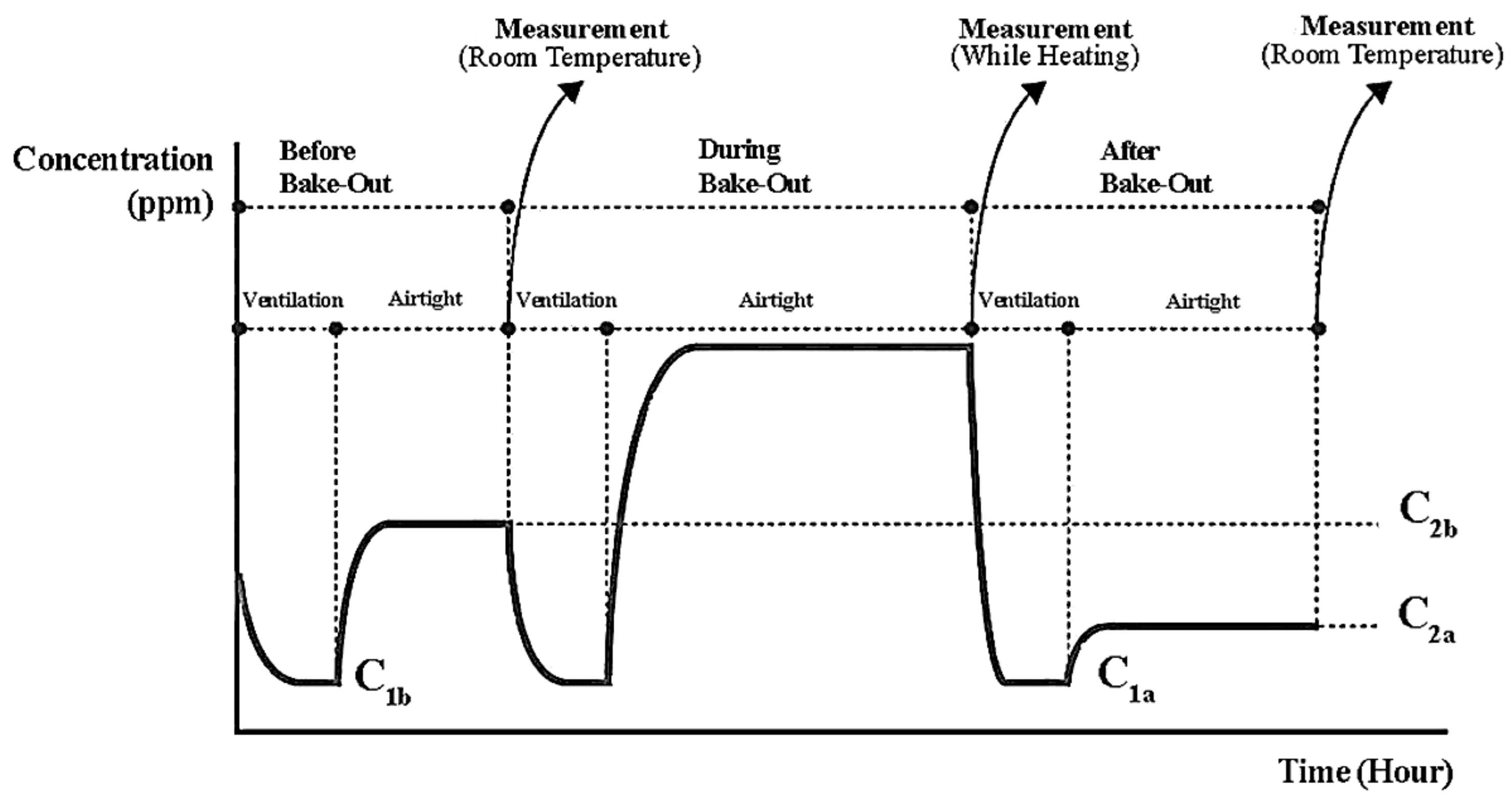
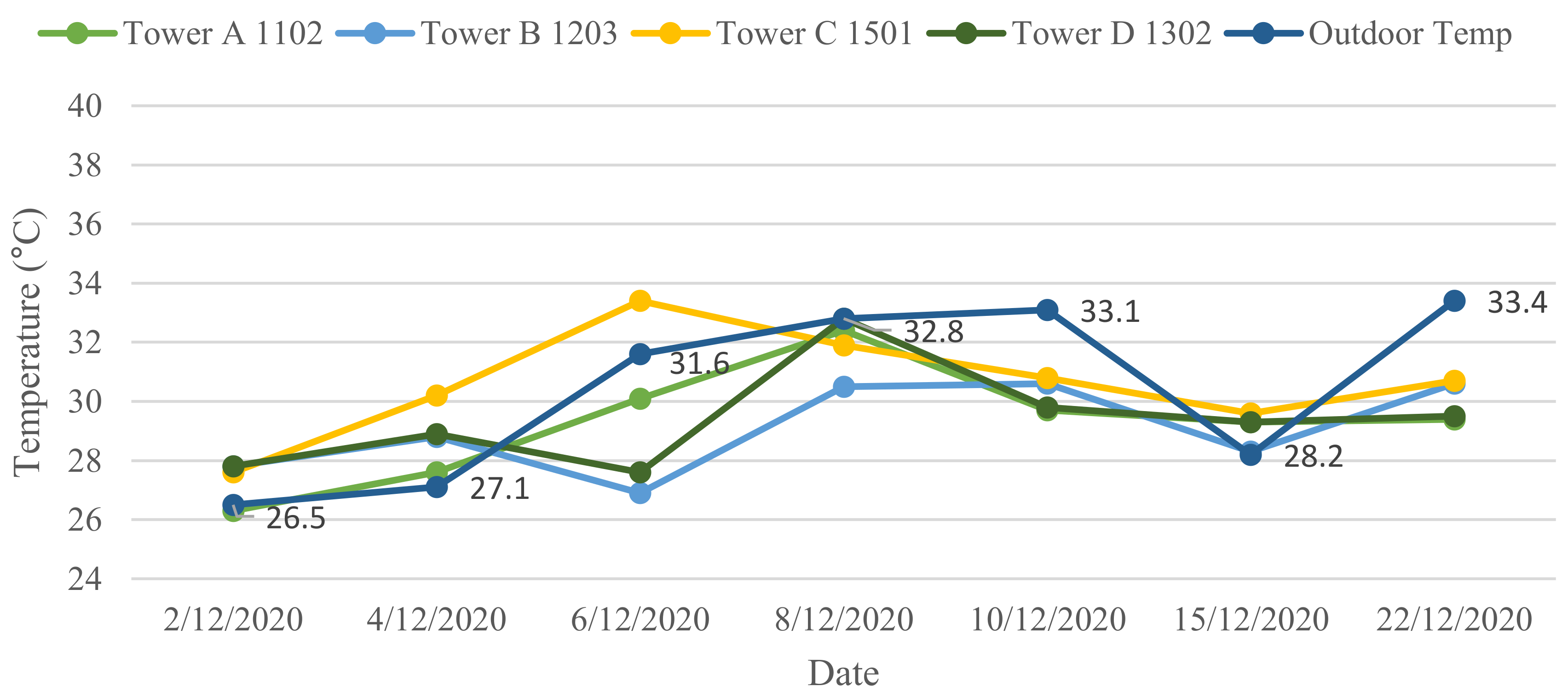

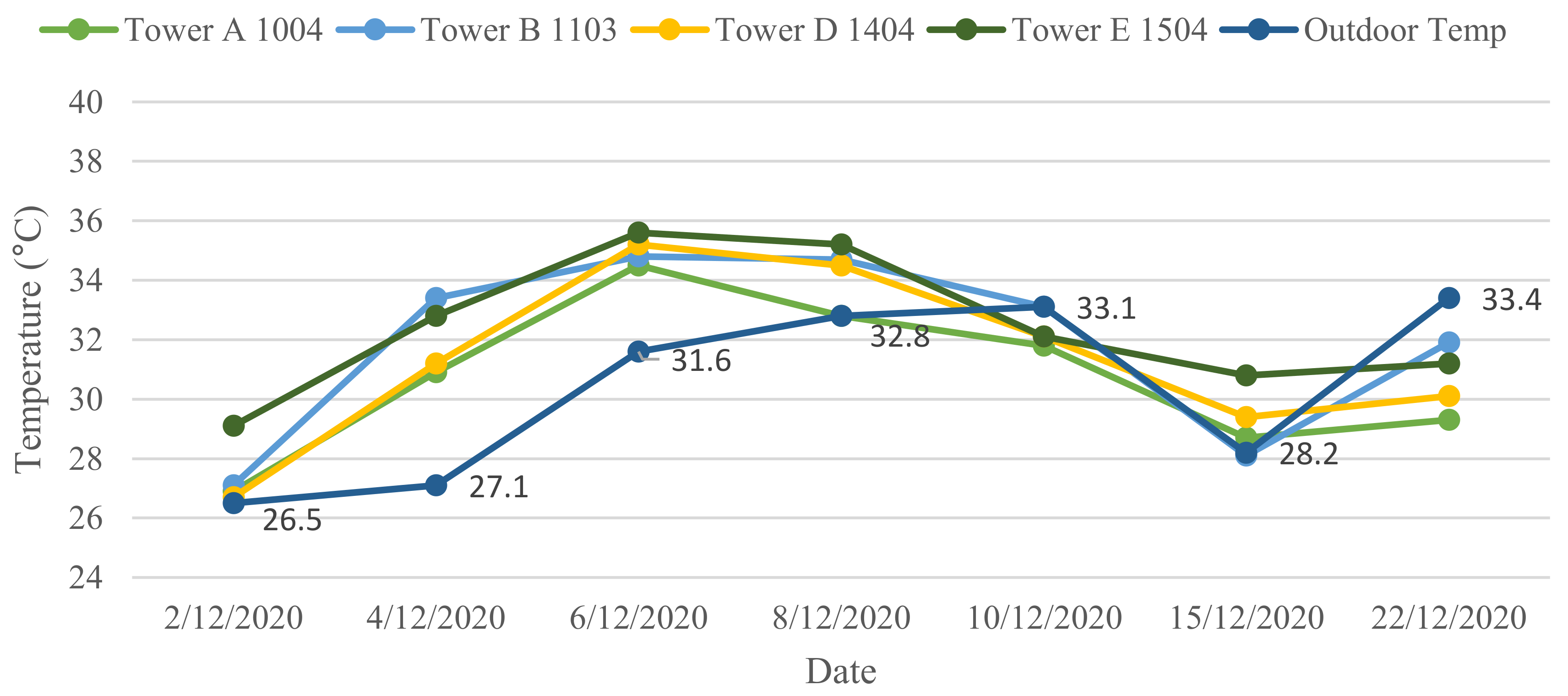
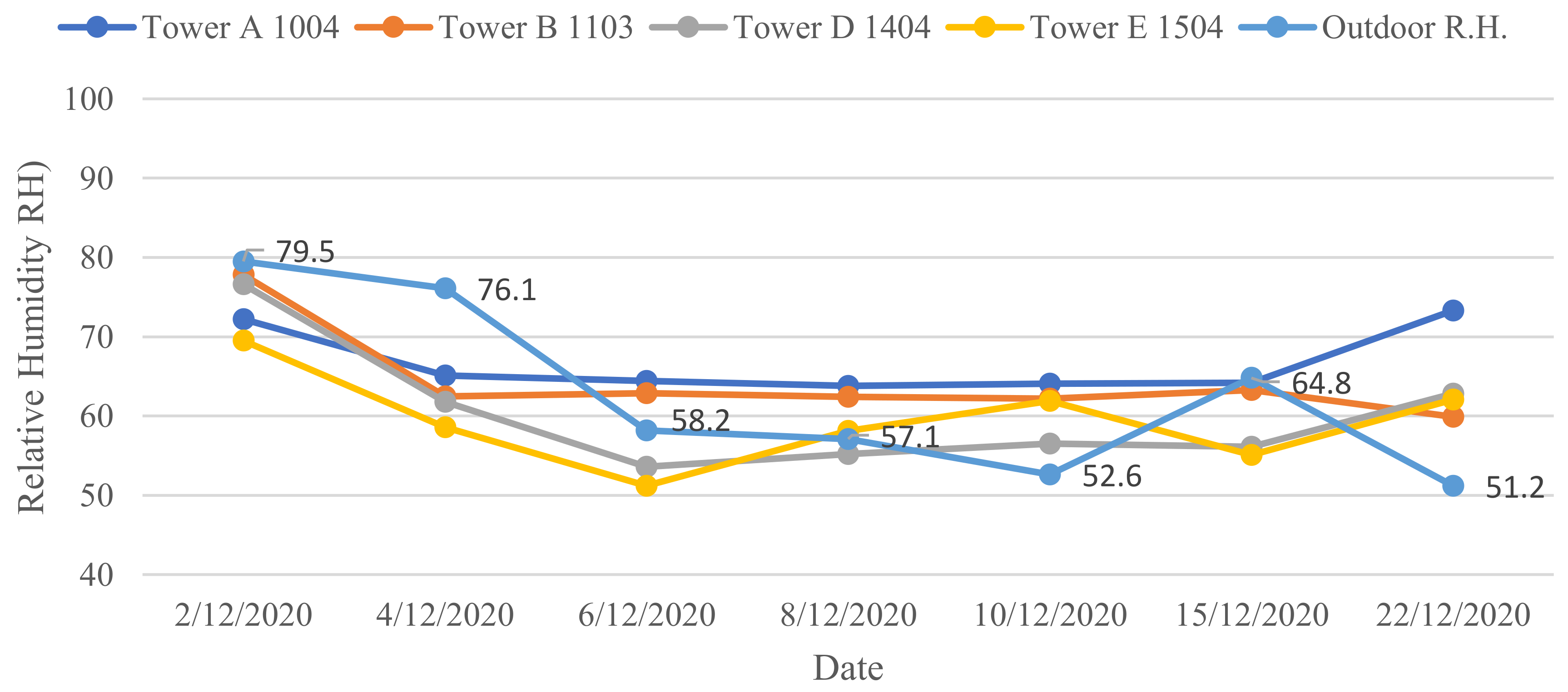
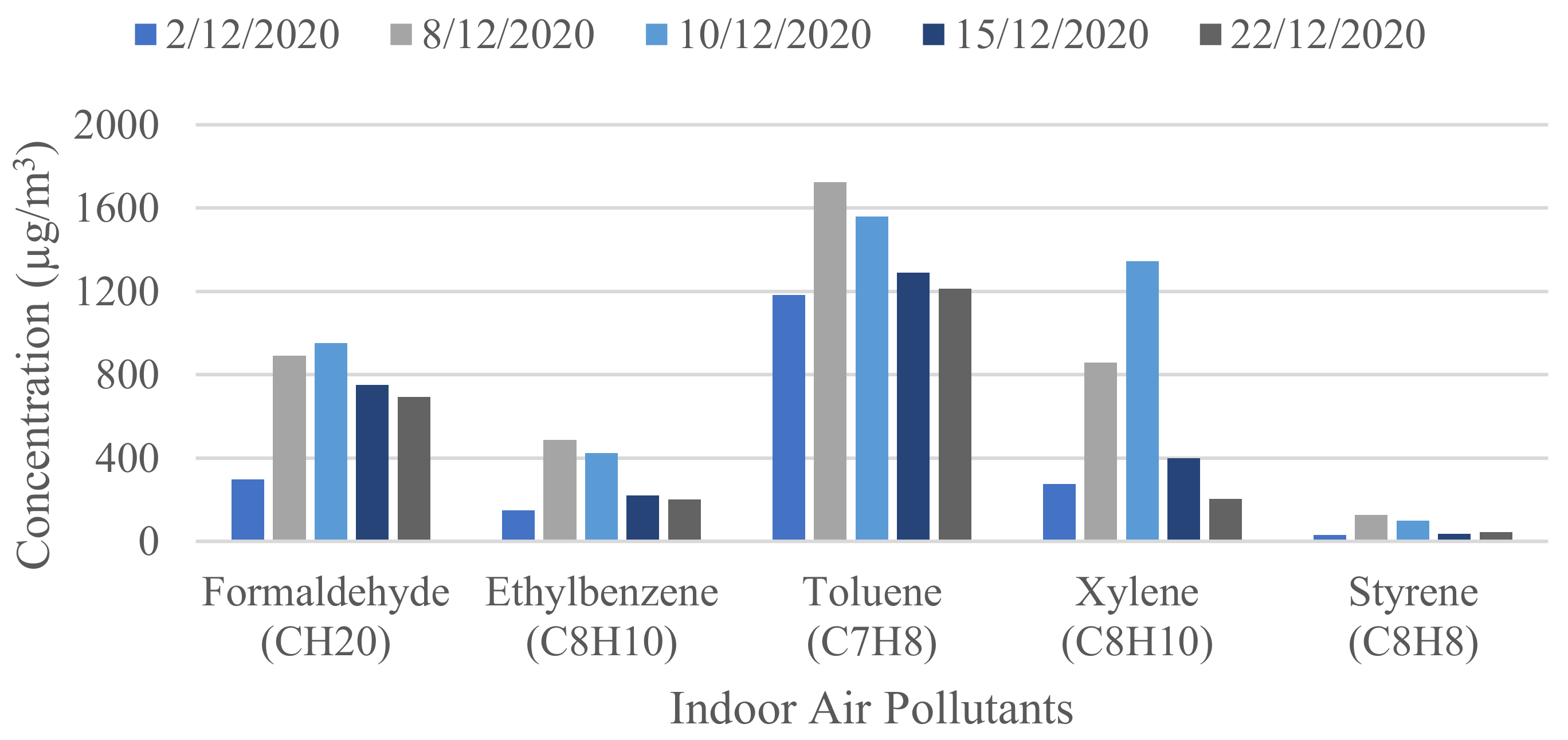
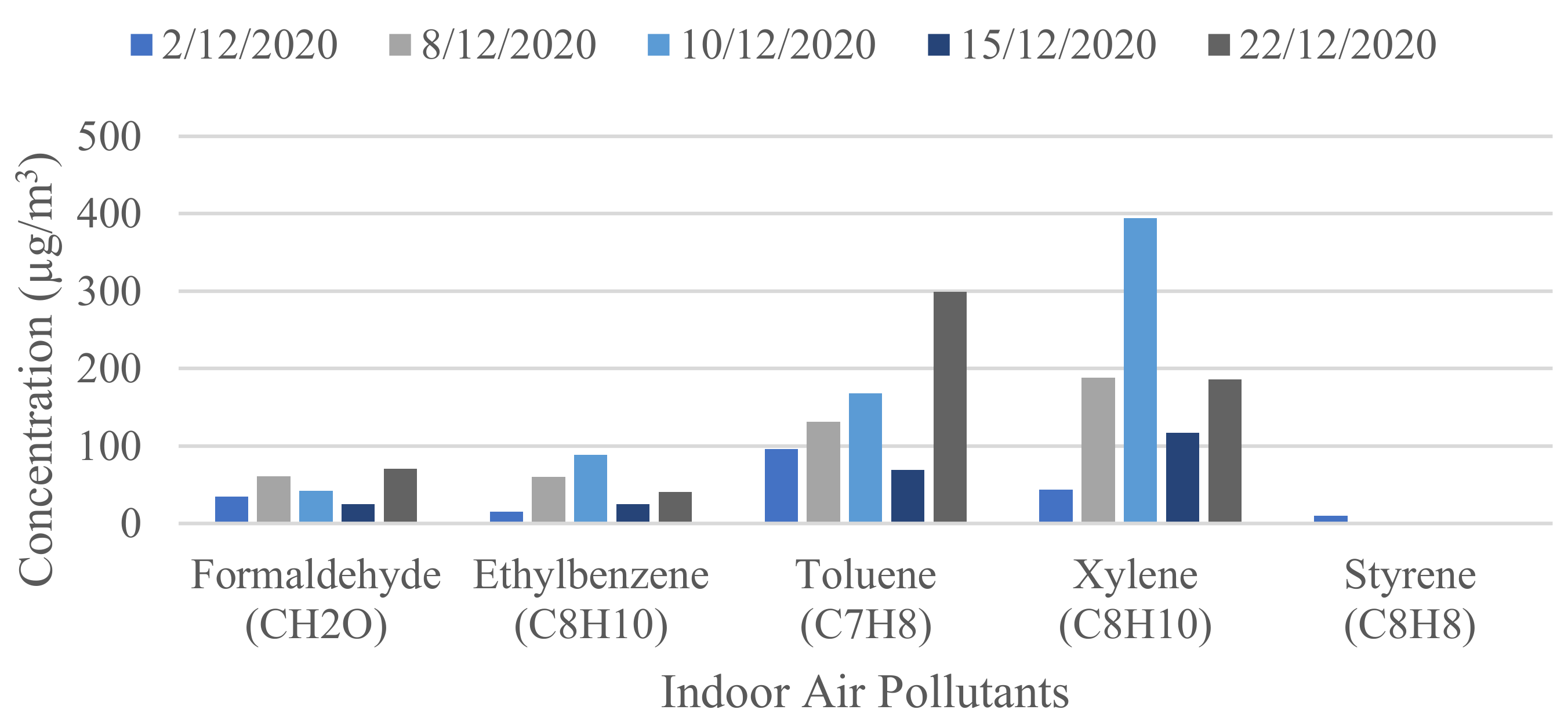






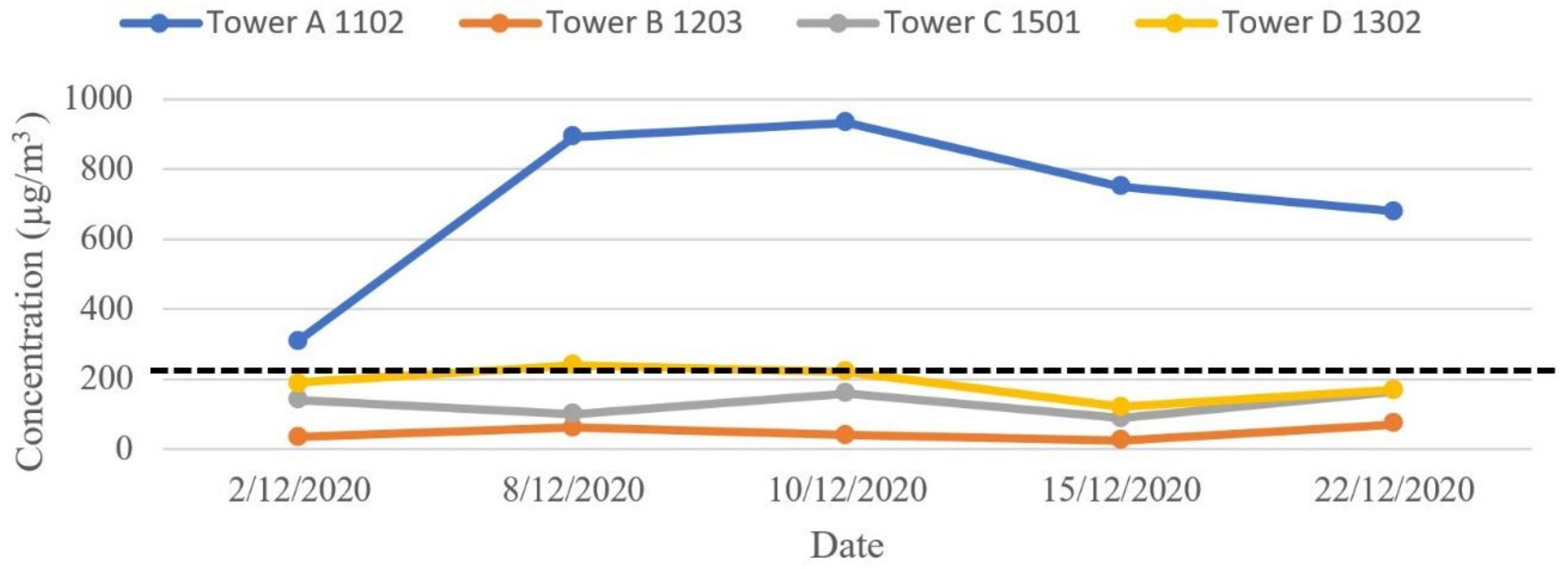

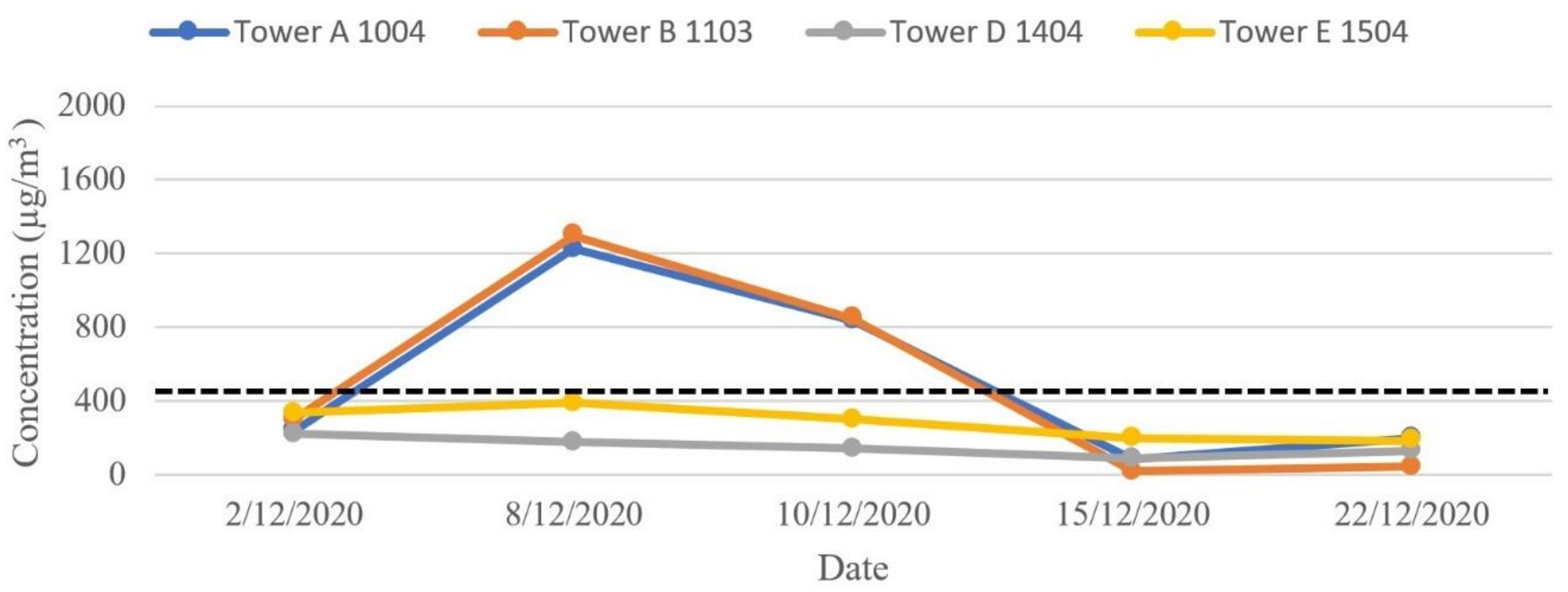

| Measuring Items | Measuring Instruments | Analysis Conditions | |
|---|---|---|---|
| VOCs | Toluene (C7H8) | - Gas Chromatograph (Agilent 8890 GC, Agilent, Santa Clara, CA, USA) - Mass Spectrometer (Agilent 5973N MSD, Agilent, Santa Clara, CA, USA) - Thermal Desorber (Agilent 7667A Mini Thermal Desorber, Agilent, Santa Clara, CA, USA) | - HP-1 Capillary Column (60 m × 0.32 µg/m × 0.25 nm) - Column Low: 1 mL/min - MS Ion Source Temperature: 260 °C - Column Temperature Rate: 60 °C (5 min) >> 5 °C/5 min to 260 °C - Split 20:1 |
| Ethylbenzene (C8H10) | |||
| Xylene (C8H10) | |||
| Styrene (C8H8) | |||
| Formaldehyde (HCHO) | - High-Performance Liquid Chromatography (Shimadzu 10AVP Series HPLC System, Shimadzu, Kyoto, Japan) | - UV detector: 360 nm - Mobile ACN:H2O = 60:40 - Extract Acetonitrile: 5 mL | |
| Room Temperature Relative Humidity | - Digital Thermo-Hygrometer (TR-72U, Tecpel, New Taipei City, Taiwan) | ||
| # | Units | Before Bake-Out | During Bake-Out | Ventilation/Measurement | After Bake-Out | Bake-Out/ No Bake-Out |
|---|---|---|---|---|---|---|
| 2 December 2020 | 4 December 2020– 6 December 2020– 8 December 2020 | 10 December 2020–15 December 2020 | 15 December 2020–22 December 2020 | |||
| 1 | Tower A1102 | Exterior Doors/Windows Kept Sealed | No Bake-out | |||
| 2 | Tower B1203 | Exterior Doors/Windows Kept Open (Natural Ventilation) | ||||
| 3 | Tower C1501 | Airtight with Air Supply/Exhaust Ventilation | ||||
| 4 | Tower D1302 | Airtight with Kitchen Hood Exhaust Fan | ||||
| 5 | Tower A1004 | Doors/Windows Sealed | Natural Ventilation | Airtight | Bake-out | |
| 6 | Tower B1103 | Doors/Windows Sealed | Natural Ventilation | Natural Ventilation | ||
| 7 | Tower D1404 | Exterior Doors/Windows are Kept Sealed, and Air Supply/Exhaust Ventilation | ||||
| 8 | Tower E1504 | Exterior Doors/Windows are Kept Sealed, and Kitchen Hood Exhaust Fan | ||||
Disclaimer/Publisher’s Note: The statements, opinions and data contained in all publications are solely those of the individual author(s) and contributor(s) and not of MDPI and/or the editor(s). MDPI and/or the editor(s) disclaim responsibility for any injury to people or property resulting from any ideas, methods, instructions or products referred to in the content. |
© 2023 by the authors. Licensee MDPI, Basel, Switzerland. This article is an open access article distributed under the terms and conditions of the Creative Commons Attribution (CC BY) license (https://creativecommons.org/licenses/by/4.0/).
Share and Cite
Abdelaziz Mahmoud, N.S.; Jung, C. Analyzing the Bake-Out Effect in Winter for the Enhancement of Indoor Air Quality at New Apartments in UAE. Buildings 2023, 13, 846. https://doi.org/10.3390/buildings13040846
Abdelaziz Mahmoud NS, Jung C. Analyzing the Bake-Out Effect in Winter for the Enhancement of Indoor Air Quality at New Apartments in UAE. Buildings. 2023; 13(4):846. https://doi.org/10.3390/buildings13040846
Chicago/Turabian StyleAbdelaziz Mahmoud, Naglaa Sami, and Chuloh Jung. 2023. "Analyzing the Bake-Out Effect in Winter for the Enhancement of Indoor Air Quality at New Apartments in UAE" Buildings 13, no. 4: 846. https://doi.org/10.3390/buildings13040846
APA StyleAbdelaziz Mahmoud, N. S., & Jung, C. (2023). Analyzing the Bake-Out Effect in Winter for the Enhancement of Indoor Air Quality at New Apartments in UAE. Buildings, 13(4), 846. https://doi.org/10.3390/buildings13040846









